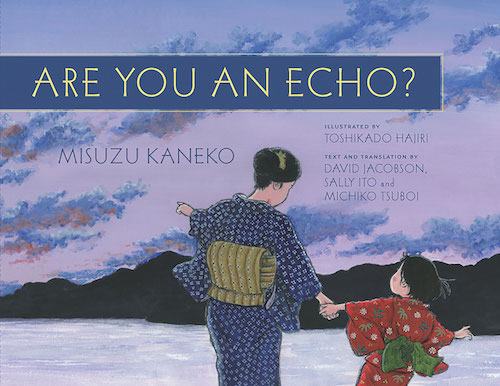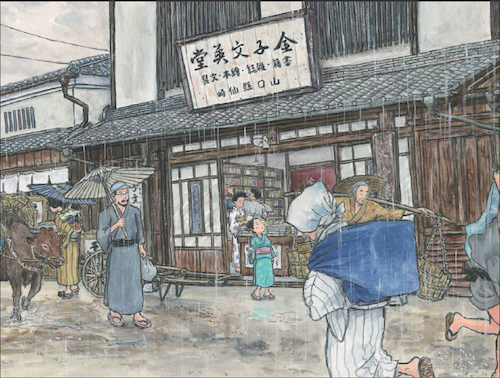Misuzu Kaneko: Everything Was Alive
Have you heard of the poet Misuzu Kaneko (1903–1930)? I hadn't until I read the new book Are You an Echo? The Lost Poetry of Misuzu Kaneko, beautifully narrated by David Jacobson and charmingly illustrated by Toshikado Hajiri. (Note that "Kaneko" is the surname, even though it certainly sounds like a given name! And "Misuzu" is a pen name.)

We can find some context in a foreword by Setsuo Yazaki (who writes children's books):
Misuzu Kaneko’s poems are part of every child’s curriculum at Japanese elementary schools. Her poems have been translated into eleven languages, and most of those editions were published overseas. It is my hope that Misuzu Kaneko’s words, which possess a deep kindness toward all things whether they are alive or inanimate, like rocks and soil, will touch the hearts of those who pick up this book. I dream that one day, when all of the world’s children grow up and set out on their journeys, that they do so with Misuzu Kaneko’s spirit in their hearts and her poems on their lips.
What a difference that would make! Kaneko's poems for children reveal "a cosmology of kindness," says Montreal-based poet and translator Erin Moure, who calls this work "almost a companion book to St. Exupery’s Little Prince!"
Like The Little Prince, the book is ostensibly for children—but speaks right to the adult heart.
To give you an idea of just how wonderful this book is and just how stirring the poems are, here's a small bit from the beginning. It introduces both Yazaki and Misuzu:
Who was Misuzu Kaneko? Setsuo Yazaki wanted to know. He read her poem "Big Catch" when he was a student, and was mesmerized.

Setsuo wondered: Who was this poet? She could understand the feelings of even the fish in the ocean!
Jacobson puts it this way in the book: "To Misuzu, everything was alive and had its own feelings—plants, rocks, even telephone poles! She felt the loneliness of whale calves orphaned after a hunt. She felt the nighttime chill of cicadas who had shed their old shells. And she felt the tearful sadness of a flower wet with dew."
As Jacobson explains, Setsuo Yazaki spent 16 years trying to find answers about this mysterious and largely forgotten poet before making a breakthrough. At that point he met her brother, age 77, who showed Yazaki 512 poems (mostly unpublished) that Misuzu had written in three battered diaries. With the brother's help, "Setsuo was finally able to piece together who Misuzu really was," writes Jacobson, who seems to have taken the baton from Yazaki, bringing us a masterful portrayal of the woman.
Incidentally, one site explains that when Yazaki first visited Misuzu's hometown of Senzaki (now part of the city of Nagato) in Yamaguchi Prefecture on Honshu, he searched for her grave and had no luck, even though he made several inquiries. Then it began to pour, washing away moss on a tombstone in front of him and revealing the inscription 金子テル. That was Misuzu's real name. It was as if she wanted him to know that she was there.
I should own up to something. I have several connections to Jacobson. He interviewed me for an article about Joy o' Kanji years ago and later did lots of excellent work that helped Joy o' Kanji immensely. I also happen to adore his book!
Here's what I emailed him right after reading it: "I love everything about it—the narrative (so beautifully written), the art, the poems themselves, the sequence of all the contents. It's utterly charming and absolutely does justice to this wonderful woman of whom I knew nothing."
Several days later, I was still so moved that I wrote this in my journal: "Astonishingly beautiful and soulful, it hit the mark in every way. It was a reminder that softness and sensitivity have enormous value despite (and actually because of) all the harshness in the world. Of course, being that sensitive didn't pay off for the poet herself (who committed suicide at age 26), but it has certainly benefited others."
You should see the book for yourself. For starters, it contains this image of the street on which Misuzu grew up in Senzaki:

The storefront, her family's bookstore, is called 金子文英堂 (かねこ ぶんえいどう), written from right to left. And the little girl in green is supposed to be the poet as a child, looking up at the rain. Books were sold on the first floor, and her family lived in the rear and upstairs. Back then, the street was much busier than it is today.
The building has become a museum commemorating her life:

Jacobson (in the blue shirt) and the illustrator (in the striped shirt) are in the photo!
According to Jacobson, 1.5 million people have visited the museum in the 13 years since it opened. Last year alone, nearly 75,000 people did so. By contrast, he says, the Walt Whitman Birthplace State Historic Site in West Hills, New York, receives 16,500 people annually. Walt Whitman is arguably a much more important poet to the United States than Misuzu is to Japan, and the United States is a much larger country, but still the Misuzu museum receives 4.5 times as many visitors. "That speaks to the reverence Japan has for her (and perhaps for poetry in general)."
Indeed, after the disasters of March 11, 2011, TV networks aired one of her poems as part of a public service announcement.
As you can see, the museum retains the original bookstore sign. Here's a closeup:

And here's the first line of smaller writing, again from right to left:
書籍 (しょせき: books)
雜誌 (ざっし: magazines), in which 雜 is the old shape of the Joyo 雑
繪本 (えほん: picture books), in which 繪 is the old shape of the Joyo 絵
文具 (ぶんぐ: stationery)
Across the bottom we find the location:
山口 (やまぐち: prefecture name)
縣 (けん: prefecture), in which the kanji is the old, non-Joyo shape of 県
仙崎 (せんざき: town name)
I know you're hungry for some of her poems, so I'll include one here in both languages, presenting more next week. Enjoy!


Sally Ito and Michiko Tsuboi translated the poems.
If you are lucky enough to be in Seattle on September 29, be sure to attend the launch party! It's at Queen Anne Book Company (1811 Queen Anne Ave. N., Seattle) at 7 p.m. Jacobson will give a short talk about Kaneko, and his colleagues Cali Kopczick and Yuko Enomoto will read a few of her poems in English and Japanese respectively. There will be time for questions, and you can look at the book, buy it, and have it signed by the esteemed author. There's a Facebook page about the event.
In all this excitement, I've nearly forgotten to mention my own writing! Essay 1261 on 絞 has posted. Here's a sneak preview:

Have a great weekend!

Comments